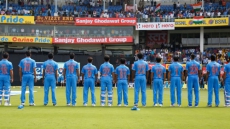In 2008, Arti Chauhan (name changed to protect identity), mother of a 12-year-old girl, a 9-year-old boy and a 6-year old girl, became aware that two pills -- mifepristone and misoprostol -- could induce an abortion, a procedure she considered when she got pregnant when her boy was just a year old.
Chauhan, 28, wife of a daily wager in Rajasthan's Sirohi district, did not want another child so soon.
"A neighbour told me about the medicine," she said. "I bought it from the medical store for Rs 500. I aborted in 10 days. It was easy. It was much cheaper than having to pay for a surgical abortion." Three years earlier, Chauhan had paid Rs 2,000 to a private doctor in Abu Road for a surgical abortion.
Chauhan's story is echoed across India: Millions of women become pregnant because they lack access to contraceptive devices to limit or space their families, or are ignorant about them. More than 10 million women terminate their pregnancies in the privacy of their homes, reflecting the government's failure to adequately address family planning needs, endangering mothers and keeping India more populated than it might be if women had access to, and knowledge of, contraceptives.
A family planning programme and budget skewed towards sterilisation leaves one in five women with an unmet need for contraception in India, according to the District Level Household and Facility Survey 2007-08.
Eliminating all unwanted births by adequately meeting the need for contraceptives would reduce India's total fertility rate below the replacement level -- a stage where the population neither increases nor decreases -- of 2.1.
India's fertility rate is currently 2.3, but if women were provided contraceptive devices and guaranteed safe abortions, the fertility rate could fall to 1.9 (the same as US, Australia and Sweden), according to a National Family Health Survey estimate.
"If the government adequately focuses on preventing unwanted births and on empowering women to make the right decisions, India's population could actually start falling," said Poonam Muttreja, executive director, The Population Foundation of India, a nongovernmental organisation working on population issues.
After the birth of her third child -- a girl she did not want -- the Chauhans wanted a second boy. A neighbour suggested contraception. "Then I started using Mala-D," she said.

Otherwise, she would be repeatedly popping pills to terminate unwanted pregnancies, with likely complications such as severe abdominal or back pain, heavy bleeding with clotting, cramps, fever, vomiting, nausea, foul-smelling discharge, perforation and injury.
An estimated 2 to 5 per cent Indian women require surgical intervention to resolve an incomplete abortion, terminate a continuing pregnancy, or control bleeding, according to the World Health Organisation.
The taking of pills to induce an abortion enters the national data as no more than pharmaceutical industry sales data. "Most of India's unreported abortions are not to terminate unwanted teenage or single-women pregnancies," said Muttreja. "Medical abortion has become a proxy contraceptive for married women from socially and economically less privileged households."
Against 0.7 million reported annual abortions, India logged sales of 11 million units of popular abortion medicines, mifepristone and misoprostol, according to Lancet, a global medical journal.
At present, Indians have a choice of five state-provisioned contraceptive methods -- condoms, combined oral pills, intra-uterine devices, male and female sterilisation -- and starting in March 2016 in Haryana, the first state to implement a new government directive, an injectable contraceptive.
"Research estimates that every new option added to this basket of choices will increase the modern contraceptive rate by 8-12 per cent," said Muttreja. With the Indian contraceptive prevalence rate at 52.4 per cent -- meaning just over half of Indian women, or their partners, are currently using contraception -- plenty of scope exists to increase the rate, which would, in turn, bode well for population control.

Surgical abortion was legalised in India with the advent of the Medical Termination of Pregnancy (MTP) Act in 1971, marking a major step forward for Indian women. "Abortions by quacks were putting women at great risk," said Suneeta Mittal, Director and Head, Obstetrics & Gynaecology, Fortis Memorial Research Institute, Gurgaon.
Until the legalisation of mifepristone and misoprostol in 2002, no more than 6 per cent of primary health centres and 31 per cent of larger community health centres nationwide offered safe abortion services. Now, women can pop pills in the privacy of their home.
"Medicine eliminates the cost and risk surrounding hospital admission, anaesthesia and surgery; and it offers more privacy than a surgical abortion," said Mangala Ramachandra, Consultant Obstetrician and Gynaecologist at the Fortis Hospitals, Bengaluru.
The gap between recorded and estimated abortions based on medicine sales suggests women are aborting foetuses, primarily female. India's gender ratio in 2011 was 940 females for 1000 males.
Another concern is the health risk to women from terminating their pregnancies unaided at home. "More than half of all abortions in India continue to be unsafe," said Vinoj Manning, Executive Director, Ipas Development Foundation, an advocacy. Among unsafe abortions, he counts home attempts as well as procedures by back-street quacks.
"Incomplete abortions have increased from around 30 per cent to over 50 per cent in the last five years, which shows the increase in unsuccessful home medical abortion attempts," he said.
One way to increase the count of abortions and track the use of medical abortion is to improve record-keeping by doctors. Incomplete abortions or post-abortion complications are currently outside the purview of the MTP Act, despite being common occurrences.
About 97 of every 100 abortion cases presenting to Kusum Lata Agarwal, a doctor in a government health facility in Abu Road, are for incomplete abortion or for the management of post-abortion complications.

Two years ago, Agarwal was trained in conducting and recording abortions by the state with support from the Ipas Development Foundation. Since then, she maintains more records than the law currently requires.
"Prior to being trained in comprehensive abortion care, I was assisting women visiting my facility for incomplete abortions but only showing such procedures as evacuations, not abortions," she said. "Our seniors never checked our records. Now I record even incomplete abortions as abortions."
Another way to control use of mifepristone and misoprostol is to make these abortion pills available only through the government, but that would impinge on a woman's right to end a pregnancy and could create new challenges for needy women, said experts.





